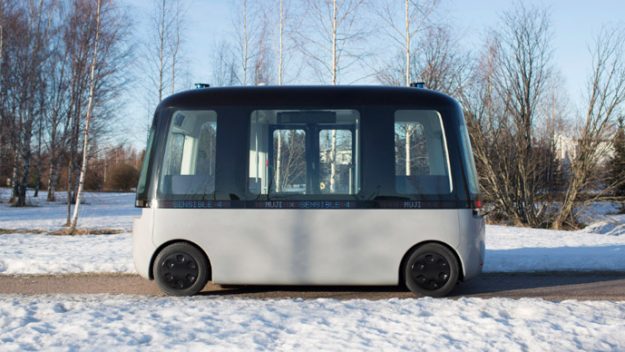Will Demand-Responsive Transport be autonomous? The Demand-Responsive autonomous vehicle has a unique disruption potential. Given the very many ongoing projects with equipment manufacturers and GAFAs, its implementation is almost palpable. However, if the technology on which Demand-Responsive Transport is based is now perfectly mastered, autonomy adds an additional operating complexity, especially in sparsely populated areas. Explanations.
Autonomous Demand-Responsive: current projects
Autonomous Demand-Responsive Transport is a transformational innovation that mobilizes many companies, startups and large groups.
Freight transportation: it will still take time before it democratizes but its potential is gigantic thanks to the growth of the e-commerce (remember that Amazon has its own freight airline which is constantly developing). If tomorrow we can do without a driver or pilot for all or part of the journey, carriers will then be able to gain in costs and flexibility. To achieve this, Boeing is launching with its subsidiary Boeing HorizonX, Tesla is making the buzz with its cybertruck and Thales is developing autonomous trains.
Intra-campus mobility: this is a subject which is operational and which is already working in a real situation, as the Belgian example shows with the site of the Solvay company. The objective is to complete the existing offer to set up shuttles in a university campus, a hospital site, a research center or a park. The route is standardized and involves few risks and interactions with other vehicles. We can also mention autonomous delivery vehicles, as it is the case in Virginia on the George Mason University campus which authorized 25 delivery robots capable of delivering meals to students. At any time, they drive on the sidewalks, avoid obstacles and pedestrians, and only the person who placed the order can access their meal inside the robot.
People transportation: Most GAFAs invest in it. On the Alphabet side, the parent company of Google, it is its subsidiary Waymo which works on it. However, this still only affects a few areas of the city of Phoenix in the United States. Many other startups are working on the subject, including the French Navya, Prophesee and AV Simulation, in particular on software management, artificial intelligence, cameras, detectors and other radars that will make these vehicles live.
Can we really do it without drivers?
Spoiler alert: no. At least not in the short or medium term. But before going into details, you have to understand what is meant by autonomous vehicle with levels which can be variable:
- Level 1 is the minimum degree of autonomy which is characterized by the simple presence of a cruise control in a conventional vehicle.
- Level 2 adds intelligent sensors which slow the vehicle down according to the behavior of other vehicles and which force it to stay within the limits of the traffic lanes. The driver must always have his hands on the steering wheel.
- Level 3 allows the vehicle to control acceleration, deceleration and direction, but the driver must be ready to take over when needed.
- Level 4 authorizes driving autonomously in certain situations known by the vehicle, such as a long journey on the highway for example, or in certain cities that are particularly well mapped and connected. But as soon as the vehicle leaves this zone, the driver must take over.
- Level 5 does not need a human driver. The vehicle does everything, all on its own, and does not need a steering wheel. The latest example to date is the Cruise developed by a GM subsidiary in the United States, but which remains in prototype form.
Today, all the experiments require an operator on board, which kills the promise of an autonomous public transport, both from a technological point of view and from a financial point of view. On the other hand, in the current context, nobody is yet ready to accept a driverless journey, even less when it comes to collective public transport. In the United States, half of Americans think that autonomous cars are more dangerous than traditional cars. A situation which may change in the future, but which means accepting to get in a driverless plane or to leave your children on a driverless school bus.
Autonomous and driverless Demand-Responsive Transport is a great promise on paper, because its model is very flexible. If the drivers disappearance is not yet up to date, this remains a goal for a lot of companies..
Autonomous vehicle on demand: the question of the “where” more than the “when”
The question of the availability of autonomous Demand-Responsive Transport is not temporal, but geographic. To say that the autonomous car will be available in 2025 or 2030 does not make sense, because it will not be able to drive itself everywhere or all the time. In some places, an autonomous car may only be so 20-30% of the time. Think in particular of urban hypercenters whose multiplicity of modes of transport could make the circulation of an autonomous vehicle incompatible in the short term. In low-density areas, frequent traffic on small, sometimes winding country roads and the many white areas (areas without internet connection) make it necessary to have a human on board. In addition to driving the Demand-Responsive Transport vehicle, it is often asked to the latter to know and master the territory in which the service is offered. Padam Mobility’s smart and dynamic Demand-Responsive Transport solutions mainly improve the mobility needs of the populations located just outside urban hypercenters. For these populations, and in particular the elderly with a precarious mobility, the contact with the driver of the vehicle still represents a highly valued human tie.
As specialists in artificial intelligence, the Padam Mobility teams of course remain in close connection with the autonomous vehicle environment and explore possible applications to the most relevant use cases.
See how to switch from Smart Mobility to Fair Mobility thanks to the Demand-Responsive Transport



